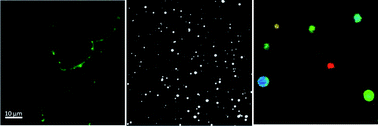Highly emissive PEG-encapsulated conjugated polymer nanoparticles†
Abstract
A novel bioimaging probe based on a

* Corresponding authors
a
Institute of Materials Research and Engineering, Agency for Science, Technology and Research, 3 Research Link, Singapore 117602
E-mail:
tomczakn@imre.a-star.edu.sg
Fax: +65-6774-4657
Tel: +65-6874 8357
b
Department of Chemical and Biomolecular Engineering, National University of Singapore, 4 Engineering Drive 4, Singapore
E-mail:
cheliub@nus.edu.sg
Fax: +65-6779-1936
Tel: +65-6516-8049
A novel bioimaging probe based on a

 Please wait while we load your content...
Something went wrong. Try again?
Please wait while we load your content...
Something went wrong. Try again?
Y. Li, J. Liu, B. Liu and N. Tomczak, Nanoscale, 2012, 4, 5694 DOI: 10.1039/C2NR31267K
To request permission to reproduce material from this article, please go to the Copyright Clearance Center request page.
If you are an author contributing to an RSC publication, you do not need to request permission provided correct acknowledgement is given.
If you are the author of this article, you do not need to request permission to reproduce figures and diagrams provided correct acknowledgement is given. If you want to reproduce the whole article in a third-party publication (excluding your thesis/dissertation for which permission is not required) please go to the Copyright Clearance Center request page.
Read more about how to correctly acknowledge RSC content.
 Fetching data from CrossRef.
Fetching data from CrossRef.
This may take some time to load.
Loading related content
